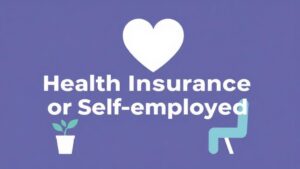Being your own boss is rewarding—you set your own schedule, pursue your passions, and control your income. But one challenge every freelancer, consultant, and small-business owner faces is finding affordable health insurance. Without an employer-sponsored plan, the responsibility for coverage rests entirely on you.
This guide explains everything self-employed professionals need to know in 2025: plan types, cost-saving tips, tax advantages, and practical steps to secure the right policy at the best price.

Why Health Insurance Is Crucial for the Self-Employed
Many entrepreneurs try to skip health insurance to save money, but the risks are high:
- Medical Emergencies Are Expensive – A single hospital stay for an accident or illness can cost tens of thousands of dollars.
- Preventive Care & Wellness – Annual checkups, screenings, and vaccinations help you stay healthy and work at your best.
- Financial Stability – Without insurance, unexpected bills can derail your business or personal finances.
In short, health insurance isn’t just protection—it’s an investment in yourself and your business.
Understanding Your Options in 2025
Health insurance for self-employed individuals falls into several categories. Each has unique benefits and costs.
1. Affordable Care Act (ACA) Marketplace Plans
- Who It’s For: Freelancers and sole proprietors with no employees.
- How It Works: Purchase coverage through Healthcare.gov (U.S.) or your state’s marketplace.
- Benefits:
- Guaranteed coverage regardless of pre-existing conditions.
- Income-based subsidies and tax credits.
- Essential health benefits (hospitalization, maternity, mental health).
2025 Update: Subsidy extensions under recent federal legislation mean many self-employed individuals pay $0–$50 per month after credits, depending on income.
2. Health Savings Account (HSA)-Eligible High Deductible Plans
- Combine a high-deductible health plan (HDHP) with a tax-advantaged HSA.
- HSAs let you save pre-tax dollars for medical expenses and invest unused funds.
- Ideal if you’re healthy and want to build long-term savings.
3. Private or Off-Marketplace Plans
- Offered directly by insurers or brokers.
- May provide more customization or broader networks.
- Useful if your income disqualifies you from ACA subsidies.
4. Professional or Trade Association Plans
- Groups like the Freelancers Union or local chambers of commerce negotiate group rates for members.
- Can be cheaper than individual policies.
5. Short-Term Health Insurance
- Temporary coverage (up to 12 months in many states).
- Lower monthly premiums but limited benefits and no guaranteed renewal.
- Best for those between plans or starting a new business.
6. Health-Sharing Ministries & Co-Ops
- Not traditional insurance but cost-sharing among members.
- Lower monthly contributions, but less regulatory protection.
- Good only if you understand the potential gaps.
Key Factors Affecting Cost
Several variables determine your monthly premium and out-of-pocket expenses:
- Age – Older individuals pay higher premiums.
- Location – Urban areas or states with fewer insurers can be pricier.
- Coverage Level – Bronze, Silver, Gold, Platinum tiers (in ACA) balance premiums vs. deductibles.
- Health Status – ACA plans don’t underwrite for health, but off-market private plans might.
- Income – Determines your eligibility for premium tax credits.

Average Costs in 2025
| Plan Type | Avg. Monthly Premium* | Deductible Range |
|---|---|---|
| ACA Silver Plan (with subsidy) | $0 – $150 | $2,000 – $6,000 |
| ACA Silver Plan (no subsidy) | $450 – $600 | $2,000 – $6,000 |
| HSA-Qualified HDHP | $300 – $500 | $3,500 – $7,500 |
| Short-Term Plan | $90 – $250 | Varies widely |
*U.S. averages; state and age significantly affect prices.
Tax Advantages for the Self-Employed
One of the biggest perks of self-employment is deducting health insurance premiums:
- Self-Employed Health Insurance Deduction – Deduct 100% of premiums paid for yourself, your spouse, and dependents from your federal income tax (even if you don’t itemize).
- Health Savings Account (HSA) – Contributions are tax-deductible, grow tax-free, and withdrawals for medical expenses are untaxed.
- Qualified Business Expense – If you hire employees, you may deduct a portion of their premiums as a business expense.
These deductions can substantially reduce the true cost of coverage.
How to Find Affordable Health Insurance: Step-by-Step
1. Calculate Your Budget
Determine how much you can comfortably spend each month on premiums and out-of-pocket costs.
2. Estimate Your Income
Marketplace subsidies are based on your modified adjusted gross income (MAGI) for the year. Use last year’s business income plus projections.
3. Compare Plans
- Visit Healthcare.gov or your state exchange.
- Use comparison tools to filter by network size, deductible, and copays.
4. Check Provider Networks
Ensure your doctors and preferred hospitals are in-network to avoid surprise bills.
5. Consider Supplemental Coverage
Look into dental, vision, or critical illness policies for extra protection.
Cost-Saving Tips for 2025
- Use Preventive Care – Most ACA plans cover screenings and vaccines with no copay.
- Increase Your Deductible – A higher deductible lowers premiums if you’re healthy.
- Leverage Telehealth – Many plans offer lower-cost virtual visits.
- Join a Professional Group – Freelance associations often secure lower group rates.
- Shop Every Year – Premiums and subsidies change annually; never auto-renew without comparing.
Common Mistakes to Avoid
- Underestimating Income – Can lead to repayment of subsidies at tax time.
- Ignoring Out-of-Pocket Costs – Low premiums can hide high deductibles.
- Skipping Coverage Entirely – Risking bankruptcy for a medical emergency isn’t worth short-term savings.
Real-World Example
Case Study: Maya, 34, Freelance Designer
Maya earns $55,000/year as a freelance graphic designer.
- She enrolled in a Silver ACA plan with a $4,000 deductible.
- After subsidies, her monthly premium is $120.
- She contributes $150/month to an HSA, lowering taxable income and building a medical savings fund.
Maya’s total healthcare spending is predictable and affordable, allowing her to focus on growing her design business.
Affordable Health Insurance Outside the U.S.
While this guide focuses on the U.S., self-employed individuals in other countries also face coverage challenges:
- Canada: Self-employed Canadians can buy private supplemental plans to cover gaps in provincial healthcare.
- U.K.: Private medical insurance provides faster access to specialists.
- India: Standalone health insurers offer affordable family floater policies for freelancers.
Wherever you live, the key is to compare plans annually and factor in tax deductions or government subsidies.
Frequently Asked Questions
Q: Can I get coverage if I have pre-existing conditions?
Yes. ACA plans are required to cover all applicants at the same rate, regardless of health.
Q: When can I enroll?
Open Enrollment typically runs from November to mid-January, but qualifying life events (marriage, moving, income change) trigger Special Enrollment Periods.
Q: What if my income fluctuates?
Estimate conservatively. You can adjust during the year or reconcile on your tax return.
Q: Is short-term insurance a good idea?
Only as a temporary bridge. It doesn’t cover pre-existing conditions or essential benefits.

The Future of Self-Employed Health Insurance
Looking ahead to 2025 and beyond:
- Expanded Subsidies: Federal and state programs continue to improve affordability.
- Telehealth Integration: More plans offer 24/7 virtual care at lower cost.
- AI-Powered Plan Matching: New digital tools help freelancers find the best policy faster.
- Wellness Incentives: Insurers reward healthy lifestyles with lower premiums.
Key Takeaways
- Self-employed professionals must secure their own health coverage, but many affordable options exist, especially through ACA marketplaces.
- HSAs provide triple tax advantages and are ideal for healthy individuals.
- Always compare plans annually and leverage tax deductions to lower net costs.
- Preventive care and telehealth can significantly reduce overall healthcare expenses.
Final Thoughts
Working for yourself provides freedom, but it also means taking charge of essential protections like health insurance. By exploring ACA plans, high-deductible options, professional association coverage, and tax-advantaged HSAs, you can find affordable health insurance that fits your lifestyle and budget.
Don’t let the complexity of the system deter you. With careful planning, you can secure comprehensive coverage, protect your finances, and focus on growing your business—all while enjoying the independence of self-employment.




